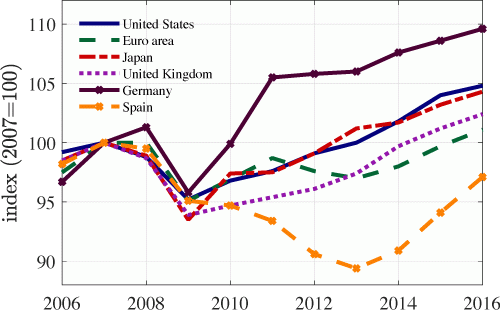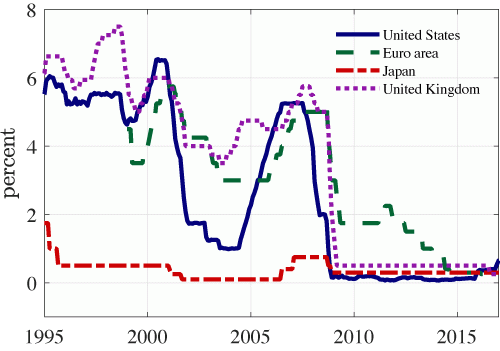In the last few years, Germany, the Netherlands, and other countries have controversially been running fiscal and current account surpluses. These policy stances seem to make sense from a national perspective – economic growth in these countries has been robust, and thus their governments are following the Keynesian notion that the "boom, not the slump, is the right time for austerity at the Treasury" (Keynes, 1937).
But running a tight fiscal policy stance against a background of low interest rates and weak global growth might produce strong contractionary spillovers toward the rest of the world (Krugman 2013, Setser 2019).
A model of a global liquidity trap
In a recent paper (Fornaro and Romei 2019), we propose a framework to think formally about this debate. We model a multi-country world in which the presence of financial frictions limits the global supply of safe assets, and depresses interest rates. If global rates are low enough, the world ends up being stuck in a global liquidity trap. Monetary policy is constrained by the zero lower bound on the interest rate, and so this is a situation in which a significant fraction of the world economy operates below full employment.
Our global liquidity trap has two key features:
- Asymmetry. There are country-specific shocks and so, during a global liquidity trap, not all countries need to be constrained by the zero lower bound and experience a recession. The model thus captures situations such as the asymmetric recovery that has characterised advanced countries after the 2008 global crisis (Figure 1).
- Persistence. A global liquidity trap is a persistent event that is expected to last for a long time. Hence, during a global liquidity trap, countries experiencing a boom in the present anticipate that they might fall into a recessionary liquidity trap in the future.1
Figure 1 Policy rates and real gross domestic product per capita
a) GDP per capita
b) Policy rates
Notes: See Fornaro and Romei (2019) for data sources.
The top panel highlights the relatively fast recoveries from the 2009 recession experienced by the US and Japan, and the slow recovery in the Euro area and in the UK. The bottom panel shows the exceptionally low interest rates after 2008. The figure also shows the heterogeneity between fast-recovering core euro area countries, captured by Germany, and the stagnation experienced by peripheral euro area countries, captured by Spain.
Prudential policies and the paradox of global thrift
We show that, during a global liquidity trap, domestically oriented governments have an incentive to implement countercyclical fiscal policies. Put simply, the reason is that reducing public debt during booms creates space for fiscal expansions during future recessions.
A similar motivation leads national governments to intervene on the financial markets to impose countercyclical macroprudential regulations (Farhi and Werning 2016, Korinek and Simsek 2016). Improving the private sector’s financial position during booms, the logic is, helps sustaining aggregate demand during future busts.
Interestingly, in a financially integrated world this prudential approach to fiscal and financial policies has an international counterpart. In fact, prudential fiscal and financial policies lead to an increase in national savings, and in the current account surpluses of booming countries.
But what happens if prudential policies are implemented on a global scale? Our fundamental insight is that the world might fall prey of a paradox of global thrift, which is essentially an international and policy-induced version of Keynes' paradox of thrift (Keynes 1933).
By stimulating national savings and current account surpluses, governments in countries undergoing a period of robust economic performance increase the global supply of savings, depressing aggregate demand around the world. Central banks in countries stuck in a liquidity trap cannot respond to the drop in global demand by lowering their policy rate. Therefore the implementation of prudential current account policies by booming countries aggravates the recession in countries experiencing a liquidity trap. And so prudential policies might backfire and, paradoxically, lead to a fall in global output and welfare.
International cooperation and Keynes’ Plan of 1941
This result sounds a note of caution on the use of prudential policies as stabilisation tools. More precisely, our framework highlights three factors that make a paradox of global thrift more likely to occur.
First, the contractionary spillovers from prudential policies are stronger when the ability of the world economy to supply assets is low, and so a paradox of global thrift is more likely to happen when the global supply of assets is scarce and inelastic.
Second, in our model the contractionary spillovers from prudential policies arise during periods of weak global demand, that is when the zero lower bound constrains monetary policy. Worryingly, scarce supply of safe assets, weak demand and low interest rates are salient features of the current state of the global economy (Caballero at al. 2016, Eggertsson et al. 2016).
Third, it's the lack of international cooperation gives rise to a paradox of global thrift in our model. Key to our results, indeed, is the fact that governments in booming countries do not take into account the negative spillovers that their policies might impose on the rest of the world. Our analysis, which resonates with the logic of Keynes' Plan of 1941, thus suggests that, when global aggregate demand is scarce, international cooperation is needed to ensure that fiscal and financial policy interventions by booming countries do not impart excessive negative spillovers on the rest of the world.2 For instance, in his 1941 plan, Keynes proposed discouraging excessively large current account surpluses by imposing simple taxes on capital outflows. It might be time to consider this type of policy.
References
Caballero, R J, E Farhi, and P-O Gourinchas (2015), “Global Imbalances and Currency Wars at the ZLB”, NBER working paper 21670.
Eggertsson, G, N Mehrotra, S Singh, and L Summers (2016), “A Contagious Malady? Open Economy Dimensions of Secular Stagnation”, IMF Economic Review 64(4): 581–634.
Eichengreen, B (2008), Globalizing Capital: A History of the International Monetary System, Princeton University Press.
Farhi, E and I Werning (2016), “A theory of macroprudential policies in the presence of nominal rigidities”, Econometrica 84(5): 1645–1704.
Fornaro, L and F Romei (forthcoming), “The paradox of global thrift", American Economic Review.
Hansen, A H (1939), “Economic Progress and Declining Population Growth”, The American Economic Review 29(1): 1–15.
Keynes, J M (1933), “An open letter to President Roosevelt,” New York Times, 16 December.
Keynes, J M (1937), “How to avoid a slump”, The Times, 12-14 January.
Korinek, A and A Simsek (2016), “Liquidity trap and excessive leverage”, American Economic Review 106(3): 699–738.
Krugman, P (2013), “The harm Germany does”, New York Times, 1 November.
Setser, B (2019), “Time for China, Germany, the Netherlands, and Korea to step up”, Council on Foreign Relations blog, 9 January.
Summers, L (2016), “The Age of Secular Stagnation”, Foreign Affairs, 15 February.
Temin, P and D Vines (2014), Keynes: useful economics for the world economy, MIT Press.
Endnotes
[1] Our global liquidity trap is then in line with secular stagnation as described by Hansen (1939) and Summers (2016). Both authors refer to secular stagnation as a long-lasting period characterised by low global interest rates, and by countries undergoing frequent liquidity traps followed by fragile recoveries.
[2] Chapter 4 of Eichengreen (2008) and Chapter 7 of Temin and Vines (2014) are two excellent sources on Keynes’ Plan of 1941. In a nutshell: Keynes saw that excessive current account surpluses by booming countries would depress global demand, and so there was a need for international rules to contain them.





